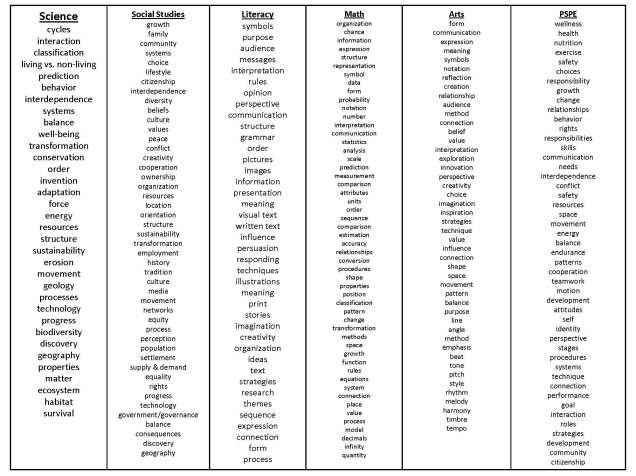Back in the fall, all of our teachers participated in an Inquiry workshop. Every teaching team seemed to walk away with two common goals:
- More purposeful and effective collaboration between teachers
We have a huge teaching staff and we have tried many models of collaboration in the past. Most of which have presented logistical obstacles or ended up not being as effective as we had hoped. So the general practice at our school ends of being that the homeroom teachers sit down together and plan the unit of inquiry and the single-subject teachers pop into the meetings for a few minutes at sit at the back of the room and listen… and maybe present a few ideas that they had planned to share.
- More purposeful and meaningful connections for the students between disciplines
The PYP is meant to be a transdisciplinary program, but as we reflected on our program we realized that for most of the year, each subject is working towards their own central idea. Which means our students can be working towards 6 different central ideas in one day!
We discussed these goals with our workshop presenter and he suggested using a Concept-Based Unit Map as a way to address both of these areas of concern.
What is a Concept-Based Unit Map?
A Concept-Based Unit Map is a planning tool that allows teachers to plan for and document both macro concepts (broad concepts that can be applied across all subjects) and micro concepts (subject specific concepts).
Great examples of Concept-Based Unit Maps can be found in Lynn Erickson’s Stirring the Head, Heart and Soul.
Why is a Concept-Based Unit Map helpful?
It allows all teachers to share the common focus of one central idea through concept-based connections, while still honoring their individual disciplines and curriculum standards. It also allows teachers to work on it in stages, so all teachers from one grade level do not to be in the same room at the same time.
So our Grade 4 team gave it a try and here is what happened.
First, our homeroom teachers planned and recorded their central idea and the macro (key) concepts for the unit.

Then our homeroom teachers mapped out the micro concepts for language, math, social studies and science. The goal here is to pick out the related, discipline-specific concepts that allow teachers to delve into the specific curriculum expectations for that subject through that conceptual lens. Since this is the first time we have planned this way, I provided the teachers with a reference sheet that has a collection of subject-specific concepts to pull from. The list is a work in progress that I have been building and is by no means, a comprehensive list of every concept for each discipline…. but it was a great starting point.
Then, when the homeroom teachers were finished with it, the single-subject teachers took turns working on it and mapping out the micro concepts for their disciplines. Once it is complete, the plan is to post it in our Multipurpose Room (where we hold weekly staff meetings) for all to see (to hopefully engender further connections and collaboration).
Here is what we noticed about this process:
Benefits
- Logistically is was manageable, as each teaching team was able to work on the map during their planning time
- It forced all of us to focus more on planning with the concepts in mind
- It made it much easier to make meaningful transdisciplinary connections (ex. It was a lot easier to have every subject working towards the concept of “position” from their discipline’s perspective [PE – position of players in a basketball game, Art – position and placement of focal points in visual arts, Math – position of shapes on a coordinate plane] than to try and force a topical connection [PE – plays a game about explorers, Art – paints a picture of explorers, Math – solves a word problem about explorers])
- It easily allowed teachers within the same grade and across grades to become more aware of what was going on in each class
- It sparked authentic conversations between teachers to further collaborate on a common task or project for the unit
Challenges
- Each team (homeroom, PE, Art, etc.) worked on the map in isolation so initially there was no dialogue between teams
- It’s on paper and our school uses Atlas Rubicon as a collaborative unit mapping program
Now we are going to use this map and continually refer to it throughout the teaching of the unit and then reflect on this process to see if it was effective in meeting our two goals of improving collaboration at a very big school, and making more meaningful connections between disciplines for our students.
We would love to hear your feedback about this process or any other tools that have been helpful in facilitating collaboration and concept-based learning at your school!



I enjoy your concepts list by subject area. Well done and great thinking!
LikeLike
This is excellent way to unpack with the teachers. Thank you so much for sharing.
LikeLike
Thanks for sharing.. it will lead towards more clear understanding about transdiciplinary planning…
LikeLike
Great work! Someone pointed me in this direction because I’m putting together a small booklet for teachers at my school who are new to inquiry and I wondered if you would mind me putting this table of cross curricular concepts at the back of the booklet for reference? Thanks. Here’s the booklet in case you wanted to check it out. https://docs.google.com/document/d/1b1Tg6xFJ5MI9-UhfbaGDsLZvTRSqfc9NsbAQSMnkohM/edit
LikeLike